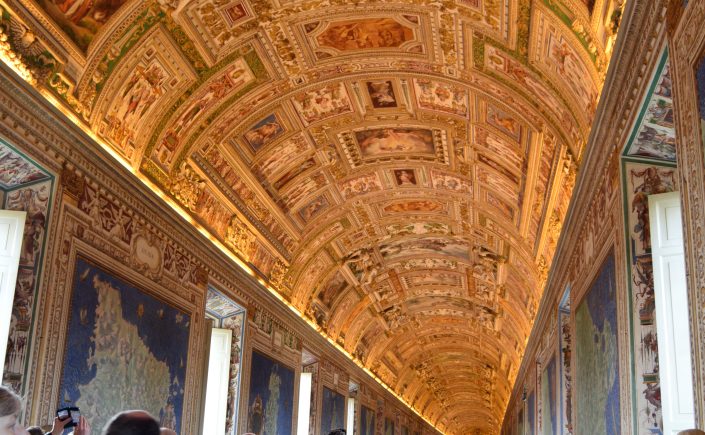The Gallery of Maps, in what is now the Vatican Museums, will be the subject of this post. The gallery, which displays forty maps in fresco form, was painted between 1580 and 1585 at the commission of Pope Gregory XIII; the maps – which depict the different regions of Italy ruled by the papacy – were based on drawings made by Ignazio Danti, a contemporary geographer and cartographer.[1] The gallery provides many insights into the power, position and political thought of the papacy at the beginning of the early modern period, but this blog will focus on three points of particular interest to me: first, the gallery’s expression of papal power and opulence; second, its reference to and support of early modern academia; and third, its function as a physical space both in the early modern period, and now.
First and foremost, the gallery was designed to construct a very specific image of Gregory XIII’s papacy; the maps – which are elaborately decorated – not only highlight the opulence of the papal court, but also emphasise that the Italian regions were papal properties, ruled and controlled by the papacy. This papal statement is important because it deliberately highlights the ‘dual character of the papal office’ – i.e. that the pope was directly involved in ‘both spiritual functions and secular lordship’ – and places great emphasis on the papacy’s ‘secular authority’ over Italy.[2] By choosing to decorate the Vatican palace with maps of papal properties, Gregory XIII embodies the early modern transition ‘towards new emphasis on the monarchical character of the papal office’ which is discussed in detail by Fernandez.[3]
This increasing emphasis on representing the Vatican as a monarchical court is also revealed by the gallery’s reference to and support for contemporary academia. During the early modern period, Rome’s papal court was ‘one of the most influential models […] for the royal households’ of Europe – it became a ‘major centre’ for both ‘politics and diplomacy’ and ‘literary and artistic tastes’.[4] The maps are geographically accurate – highlighting the papacy’s involvement in contemporary scientific discovery and innovation – but interestingly, they also frequently allude to themes and ideology from classical Rome, which had begun to appear ‘prominently in court iconography’ all over Europe during this period.[5] The inclusion of these themes allowed the pope to assert a threefold authority over early modern Europe: not only was he a spiritual leader, but his secular court was at the forefront of scientific innovation and discovery; and if that wasn’t enough to assert his dominance, the pope could still claim to be a descendent of imperial Rome, a successor of the ‘deified Roman emperors’ who had conquered the world.[6]
Even today, a lot of the power in the gallery is in how it functions as a physical space. As Fernandez argues, the rooms of the Vatican Palace were ‘primarily created to provide a setting for pageantry and ceremonial’ – in the gallery, architecture plays an important role in the construction of that setting.[7] The room is very long and narrow, with a seemingly eternal and heavily gilded ceiling; the maps – which stretch floor to ceiling – line the walls on either side. The ceiling is particularly striking; it seems to go on forever, symbolising the eternal might and perpetual expansion of the regional properties of papal Rome. The creation of such a setting is undoubtedly deliberate; the combination of contemporary and opulent architecture, scientific innovation and classical ideology solidify the image of the papacy as an ‘influential model’ for the rest of Europe.[8]
When examined in greater detail, these points may be beneficial to wider studies in this field; I believe that the gallery is vitally important in providing an insight into the carefully constructed papal imagery of the early modern period. As I have suggested, Gregory XIII deliberately sought to connect himself and his papacy with Rome; in his creation of the gallery, Gregory became one of many who sought to represent and rule ‘the city as something more than a city, as an idea or symbol of grandeur […], Christianity, imperium, and beauty’.[9] This manipulation of the idea of Rome is as relevant today as it was in the early modern period; as McCahill suggests, the ‘city has grown slowly over time, each era and ideal superimposed on the last’ – the gallery then, can help us not only to understand early modern representations, but also modern perceptions of both the papacy and Rome.[10]
[1] ‘The Gallery of Maps’, in Vatican State Website
<https://www.vaticanstate.va/content/en/monumenti/musei-vaticani/galleria-delle-carte geografiche.paginate.1.html> [accessed 14th April 2018]
[2] I. S. Robinson, ‘Rome and the Patrimony of St. Peter’, in I. S. Robinson, The Papacy 1073 – 1198: Continuity and Innovation, (Cambridge: Cambridge University Press, 1996), pp. 3 – 31, (pp. 18 – 20).
[3] Henry Dietrich Fernandez, ‘The Patrimony of St. Peter: The Papal Court at Rome c. 1450 – 1700’, in John Adamson, The Princely Courts of Europe 1500 – 1750, (London: Seven Dials, 1999), pp. 141 – 164, (p. 141).
[4] Fernandez, p. 142.
[5] Fernandez, p. 153.
[6] Fernandez, p. 153.
[7] Fernandez, p. 147.
[8] Fernandez, p. 142.
[9] Elizabeth McCahill, Reviving the Eternal City: Rome and the Papal Court 1420 – 1447, (Harvard: Harvard University Press, 2013), (p. 1).
[10] McCahill, p. 1.

